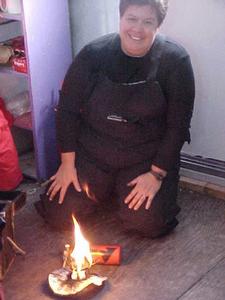30 October, 2001
Snow School
Wow! They don't waste any time around here. I only got in yesterday with not much time to acclimate to my new home and climate, and they shipped me off to snow school early this morning with two of my expedition team memebers: Dan Dixon and Lynn Peters. Dan is from London and currently lives in Maine. He is working on his Master of Science by studying the chemistry of the ice cores that we'll be collecting. Lynn joins us from Oregon and is our Caterpillar tractor mechanic, an extremely important job considering we'll be depending on him for transportation. When he's not working on tractor maintenance, he will be helping around the camp where needed. There is always plenty of work to do, so I'm sure he'll be kept busy.
Anyway, back to snow school. We drove out onto the Ross Ice Shelf with 11 others and went into a canvas hut. The first thing we learned was how to recognize the early stages of hypothermia (dangerously low body temperature), frostbite, and dehydration. If you can prevent these three things, then you have a very good chance of survival in severe weather.
We were then showed the equipment that is supplied in our survival kit. If we are ever caught out in the bad weather away from camp, this kit will be very important to us. First we had to learn to light the stove. It is similar to a Coleman camping stove (if you've ever been camping) except it is much smaller.
Our next job was to go out on the ice and set up camp using our kit. We all pitched in to build an igloo for shelter. It was a lot of work, but it went fast with so many people. Then we had to pitch our tents, and yes, you can pitch a tent in hard packed snow. The tent stakes are iron spikes that can be pounded into the ice fairly easily.
Then came the really hard work: cutting out blocks of snow and building a wind break for the kitchen area and some smaller tents. We used snow saws to cut the blocks and stack them like legos to make a wall. It is exhausting work, but well worth it if it's going to save your life. Everyone chipped in whole-heartedly. As we built the ice-block wall, we fired up the stove and started heating water for our dehydrated dinner. Next we had to learn how to set up the tents. It is not very hard, but by the time we were done, it was 7:00 PM, and we had been out in the cold for 6 hours without a break.
It can be kind of tricky when you stay outside for so long. You have to dress really warm, but when you start to work, you get too warm. Then when you take a break, you get cold again. So I had to be very aware of my body temperature and not get too warm to the point of sweating. Some tricks we learned to stay warm were to exercise to get the blood moving, eat something to get your digestive system working, and put on more clothes. I found that I was very clumsy in all my gear, and the pace of work was slower than usual.
Dinner was not very good, but again, in a survival situation, it was good enough. Our instructors said good night and left for the canvas hut for the night. We were left to finish the wall and set up our sleeping bags in the tents. We were given two thin cushions, a very warm sleeping bag, and a sleeping bag liner made out of fleece for extra warmth. Did I make it through the night???? Stay tuned......
Temperature that night: -20 C, -5 F
Wind: 15 knots

Jan succcessfully lights the stove.

One person actually spent the night in the igloo.

Home Sweet Home.
Contact the TEA in the field at
.
If you cannot connect through your browser, copy the
TEA's e-mail address in the "To:" line of
your favorite e-mail package.
|
